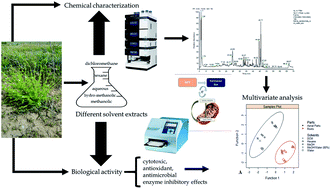Chemical characterization, cytotoxic, antioxidant, antimicrobial, and enzyme inhibitory effects of different extracts from one sage (Salvia ceratophylla L.) from Turkey: open a new window on industrial purposes
Abstract
In the present study, the methanolic, hydro-methanolic, dichloromethane, hexane and aqueous extracts of Salvia ceratophylla L. (Family: Lamiaceae), a lemon-scented herb, were tested for total phenolic (TPC) and flavonoid content (TFC) and antioxidant activities were evaluated using a battery of assays (2,2-diphenyl-1-picrylhydrazyl (DPPH), 2,2-azino-bis(3-ethylbenzothiazoline-6-sulfonic acid) (ABTS), ferric reducing antioxidant power (FRAP), cupric reducing antioxidant capacity, total antioxidant capacity (TAC) (phosphomolybdenum) and metal chelating). Enzyme inhibitory effects were investigated using acetyl- (AChE), butyryl-cholinesterase (BChE), tyrosinase, α-amylase and α-glucosidase as target enzymes. Regarding the cytotoxic abilities, HepG2, B164A5 and S17 cell lines were used. The phytochemical profile was conducted using liquid chromatography-mass spectrometry/mass spectrometry (LC-MS/MS). Our data showed that the methanolic aerial extracts possessed the highest phenolic (72.50 ± 0.63 mg gallic acid equivalent per g) and flavonoid (43.77 ± 1.09 mg rutin equivalent per g) contents. The hydro-methanolic aerial extract showed significant DPPH radical scavenging activity (193.40 ± 0.27 mg TE per g) and the highest reducing potential against CUPRAC (377.93 ± 2.38 mg TE per g). The best tyrosinase activity was observed with dichloromethane root extract (125.45 ± 1.41 mg kojic acid equivalent per g). Among the tested extracts, hexane root extract exerted the highest antimicrobial potential with a minimum inhibitory concentration value of 0.048 mg mL−1. Methanolic root extract showed the lowest cytotoxicity (28%) against HepG2 cells. Phytochemical analysis revealed the presence of important polyphenolic compounds including luteolin, gallic acid, rosmarinic acid, to name a few. This research can be used as one methodological starting point for further investigations on this lemon-scented herb.



 Please wait while we load your content...
Please wait while we load your content...